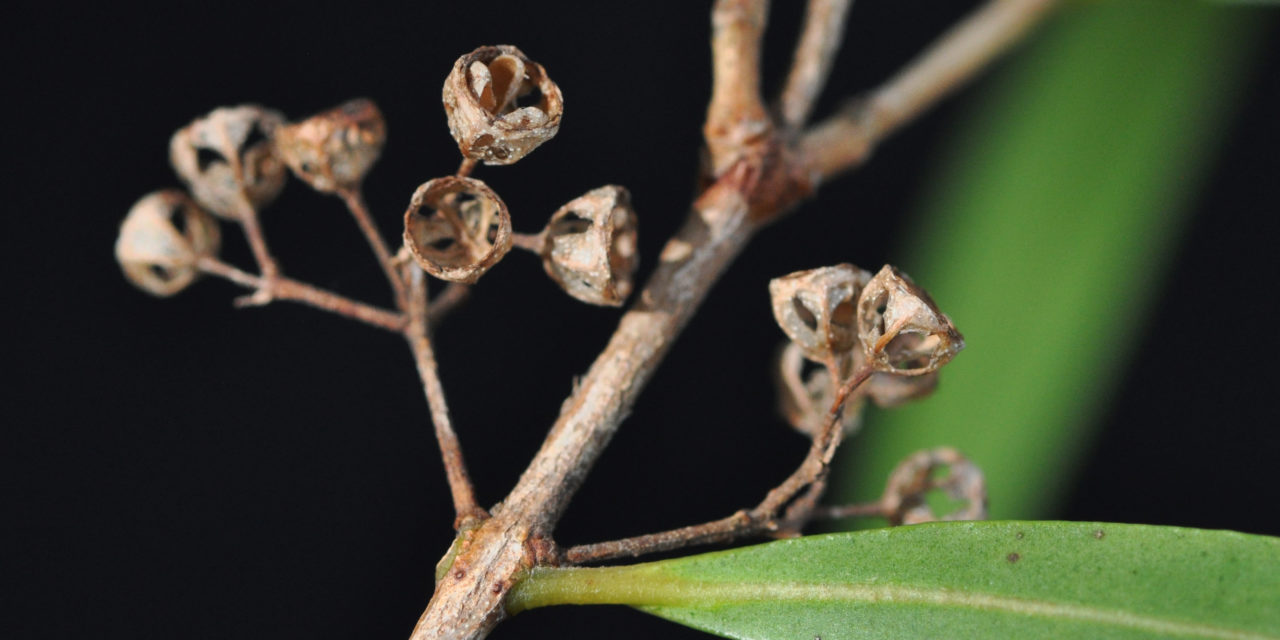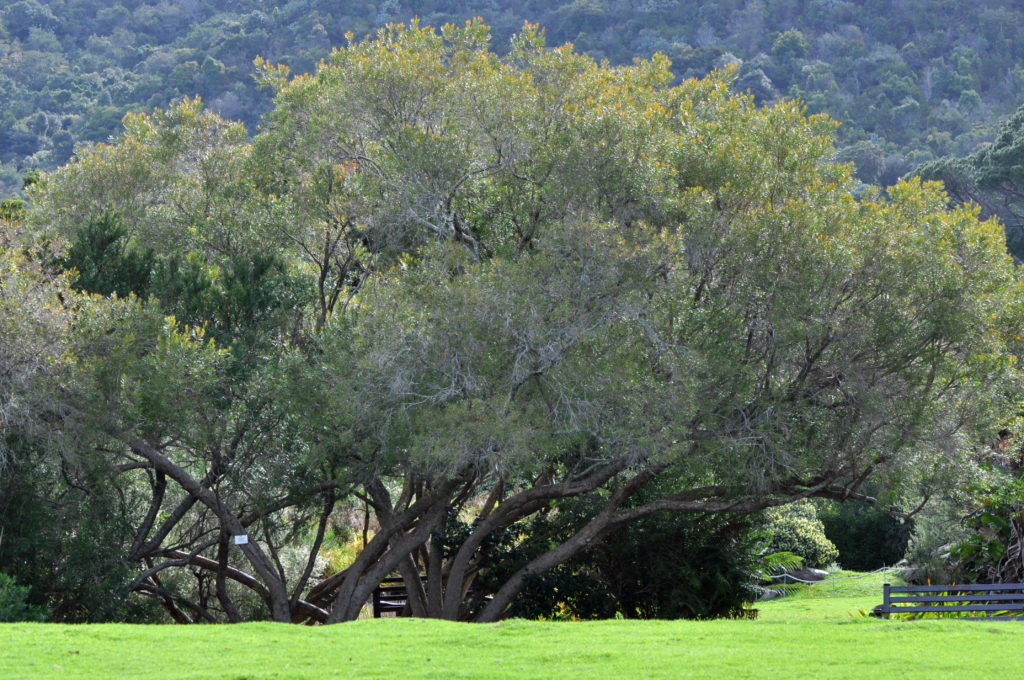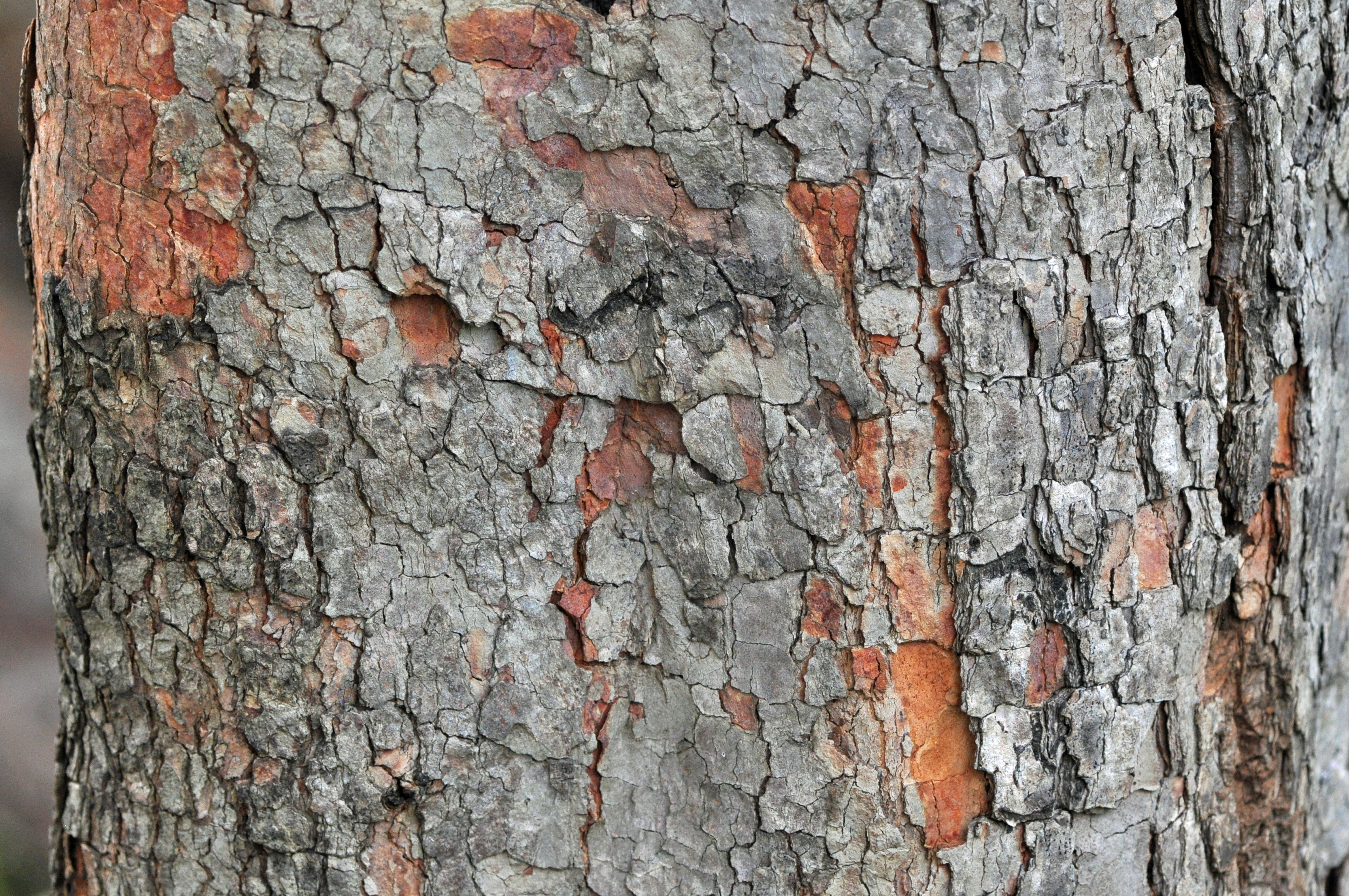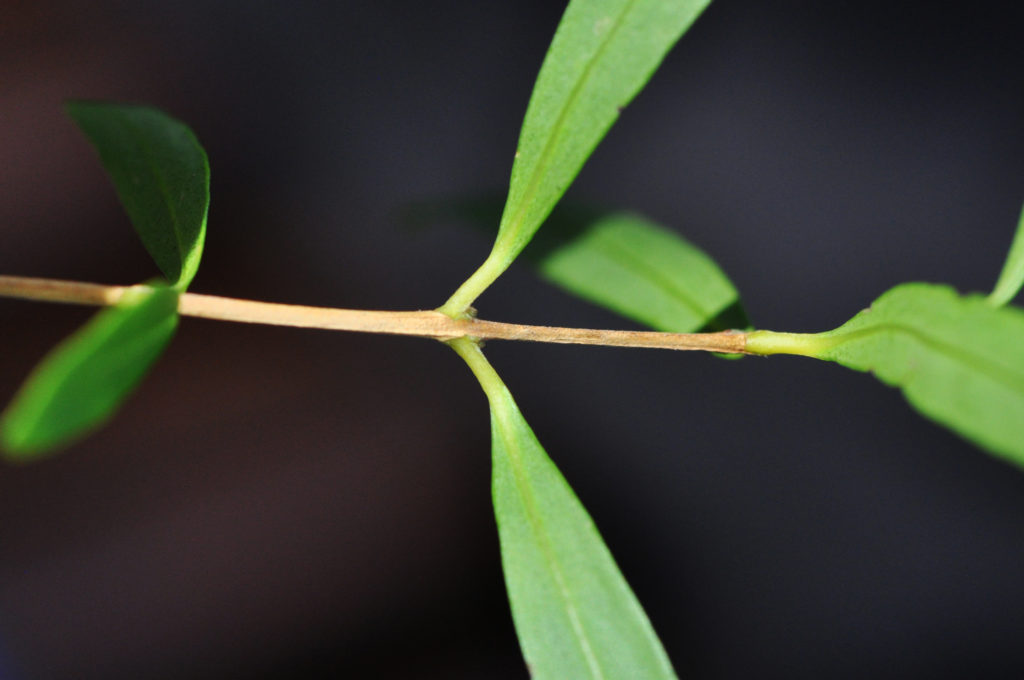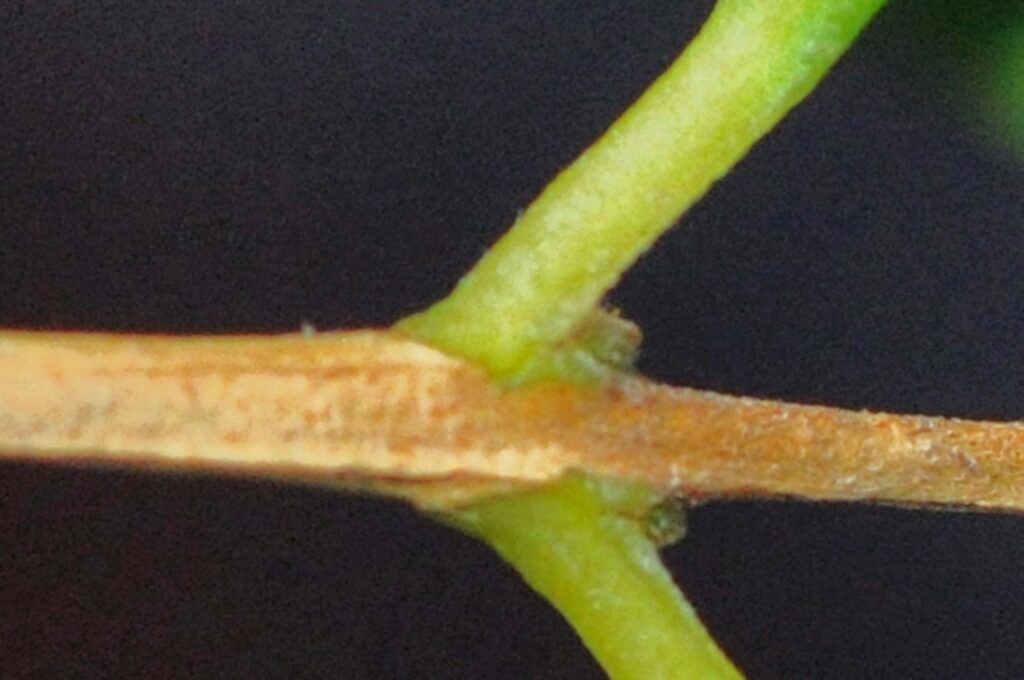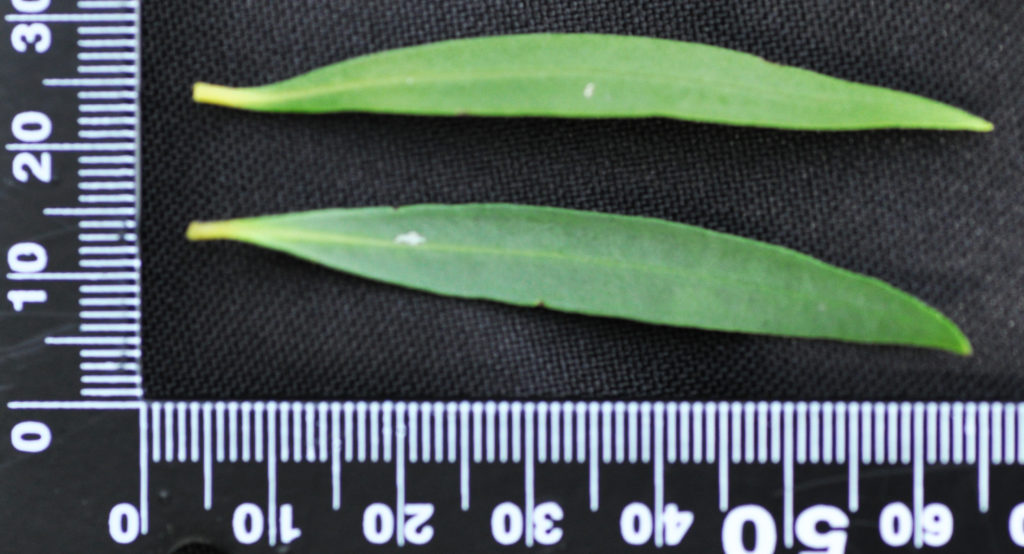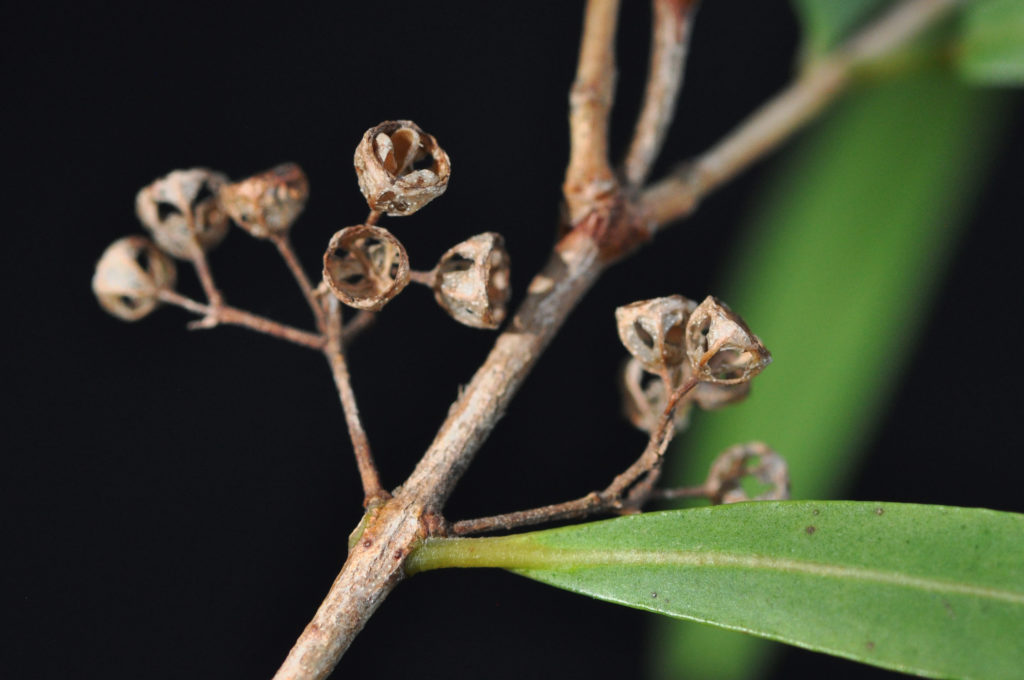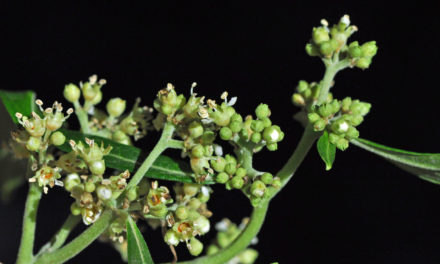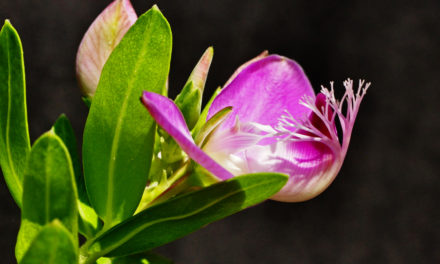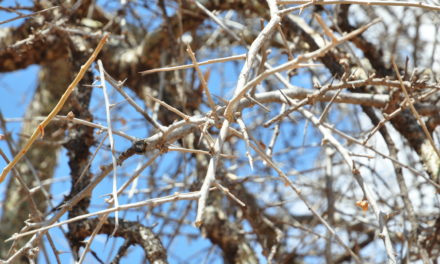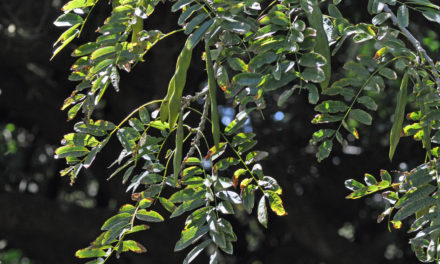General Info – summary
This shallow rooted, deciduous Tree is up to 15m high with a wider canopy. The bark becomes deeply fissured and dark. Compound Leaves are bipinnate. Bisexual 5-merous sweet-scented lilac coloured Flowers are actinomorphic with 10 stamens and a single pistil with a superior ovary. Fruit is a one seeded drupe. This attractive tree is considered Invasive, and planting has been banned in South Africa.
Description
Metrosideros angustifolia
Previous Name: Myrtus angustifolia.
SA Tree No. 559.
Common names: (Afr) Smalblaar, Smalblad. (Eng) Cape-gum, Lance-leaved ironheart, Lance-leaved Myrtle.
Family: Myrtaceae (Myrtle and Eucalyptus family) has 130+ genera and 3 000+ species and includes the Australian genus Eucalyptus, as well as guava and clove. These mostly evergreen trees have simple Leaves that are leathery, usually entire, gland-dotted and usually opposite. Stipules are very small or absent. Flowers are regular usually bisexual and 4 or 5-merous. However petals may be small or absent. The many Stamens are inflexed in the bud and Anthers are 2-thecous (with 2 pollen sacs). They usually open by lengthwise slits. The usually inferior Ovary has a simple Style with a capitate Stigma. The Fruit is a capsule or berry with a persistent Calyx. Local genera with trees on this website include include Eugenia, Heteropyxis, Metrosideros (Western Cape) and Syzygium.
Name derivation: Metrosideros – Greek: metra “the heart or the tree” and sideros “iron” referring to the hard wood in some species. angustifolia – narrow leaved. There are about 60 species of Metrosideros worldwide. Metrosideros angustifolia is the only indigenous species occurring in South Africa.
Conservation: National Status: L C (Least Concern). Assessed 2005 (W. Foden and L. Potter). The population is stable. Concern has been expressed about a fungus Holocryphia capensis that attacks this plant. This fungus causes lesions on the branches. This will have to be carefully monitored.
Tree
This plant may be a shrub or a small Tree to about 4m high with a V-shaped canopy (photo 11). The Bark is brown to grey, rough and moderately flaky. This flaking reveals an Orange underbark (photos 03). The Branches are erect and young branches are almost square (photo 07E – under Leaves).
- 11 2018.09.15 Kirstenbosch NBG. Photo: David Becking.
- 03 2018.09.15 Kirstenbosch NBG. Photo: David Becking.
Leaves
This evergreen tree has hairless Leaves that are distichous (arranged in two vertical rows on opposite sides of the stem (photo 07) and simple (have a single blade that may have incisions that are not deep enough to divide the leaf into leaflets). In this photo, the opposite pairs of leaves are decussate (arranged in pairs each at right angles to the next pair above or below i.e., rotated 90 degrees along the stem when viewed from above (photo 07E). The relatively long leaves are leathery, narrowly elliptic, and up to 9 x 1,1cm (photo 10). The Blade is slightly lighter below. The leaves taper to both the Apex and Base. The Midrib is the only clearly visible vein that is indented above and lighter below. The Margin is smooth and entire (with a smooth edge throughout – photo 10) and the Petiole (leaf stalk) is short (up to 0,5cm) and thin but partly obscured by the leaf base which is decurrent (leaf blades that partly wrap or have wings around the stem or petiole – photo 07). When held up against the sun, tiny glands, appearing as dots, are visible. Stipules (basal appendage of the petiole) are absent.
- 07 2018.09.15 Kirstenbosch NBG. Photo: David Becking.
- 07E 2018.09.15 Kirstenbosch NBG. Photo: David Becking.
- 10 2018.09.15 Kirstenbosch NBG. Photo: David Becking.
Flowers
The bisexual, white to cream Flowers are not easily seen among the leaves and are actinomorphic (Regular, symmetrical. Flowers are vertically divisible into similar halves by more than 1 plane passing through the axis). Small individual 5-merous flowers are up to 6mm wide and arise terminally or axillary. They appear collectively in up to 2,5 x 2cm Cymes (a broad, more or less flat-topped, determinate flower cluster, with central flowers opening first). They have a brief presence. The 5 lobed, short Calyx is bell-shaped and the 5 sepal lobes have overlapping edges. There are 5 free, spreading, white or geenish Petal lobes that are longer than the sepals and are obovate to spatulate. The many (20+) free conspicuous Stamens are in 1 to many whorls and only inflexed in the bud. They open to become a conspicuously yellow, white, or cream coloured mass. The Filaments are much longer than the petals. The small Anthers are versatile (hung or attached near the middle, and usually moving freely). These anthers are free and 2-thecous (with 2 pollen sacs). They usually dehisce longitudinally to release pollen. The semi-inferior Ovary is usually 3 chambered. The simple Style is shorter than the stamens. (Oct-Feb).
Fruit
The Fruit is a pale brown, 3-valved Capsule (a dry fruit resulting from the maturing of a compound ovary which usually opens at maturity by one or more lines of dehiscence). The small capsules are wider than high (up to 4 x 3mm) and develop on short stalks (photo 04). They may appear in profusion. The persistent Calyx (photo 04) usually encloses the capsule from which it may emerge slightly. Each locule within the capsule produces many variously shaped Seeds.
- 04 2018.09.15 Kirstenbosch NBG. Photo: David Becking.
Distribution & Ecology
Most species of the genus Metrosideros occur in Australia, New Zealand, Polynesia (1 000+ islands scattered over the central and southern Pacific Ocean) and the Malay Archipelago (a stretch of seawater containing many islands) between mainland Indochina and Australia). Metrosideros angustifolia is the only species that occurs in South Africa. This tree is Endemic in the winter rainfall Fynbos Biome of the Western Cape. (Endemism is the ecological state of a species being unique to a defined geographic location). It occurs from Clanwilliam (229km North of Cape Town), includes the Cederberg Wilderness area) to the Riversdale district (to the west of Mossel Bay). In this mountainous area, the plant commonly occurs along cliff bases as well as being more numerous along local streams. It often grows together with the Wild or African almond – Brabeium stellatifolium and the willow-like Searsia angustifolia. The Cape-gum (Metrosideros angustifolia) thrives in the wet acidic soil derived from weathered sandstone (a sedimentary rock containing silicate grains). The fruit attracts animals including birds. Pollination involves insects, including bees.
Ethnobotany
This pioneer Plant can help disturbed soil to recover. Current growth forms are rather small to warrant much use to be made of the Timber. Propagation: Collected Seeds must immediately be planted in weathered sandstone. Once germinated they should be planted in full sun and watered regularly. Bonsai growers use the plant.
References
Coates Palgrave, M. 2002. Keith Coates Palgrave Trees of Southern Africa, edn 3. Struik, Cape Town.
Foden, W. & Potter, L. 2005. Metrosideros angustifolia (L.) Sm. National Assessment: Red List of South African Plants version 2020.1. Accessed on 2023/09/08.
Lawrence, G. H. M, 1951. Taxonomy of Vascular Plants. The Macmillan Company, New York. Tenth Printing 1965.
Palmer, E. & Pitman, N. 1972. Trees of southern Africa. Balkema, Amsterdam, Cape Town.
van Wyk, B. & van Wyk, P. 1997 Field guide to Trees of Southern Africa. Struik, Cape Town.
http://posa.sanbi.org/flora/browse.php?src=SP
http://pza.sanbi.org/metrosideros-angustifolia
https://link.springer.com/article/10.1007/s13313-016-0399-2
https://www.sciencedirect.com/science/article/pii/S1878614613000342
http://creativecommons.org/licenses/by/3.0

